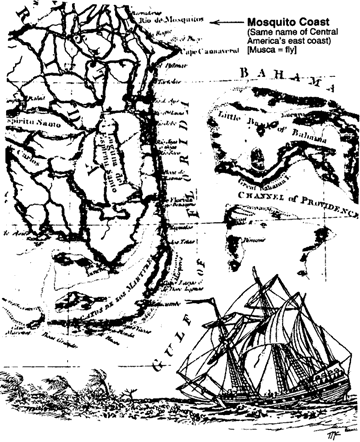
FLORIDA AND THE BAHAMAS c.1763
CARLOS = Calos
ESPIRITU SANTO = The Spirited Saint
LOS MARTYRES = THE "SEA-TREES" = Coral forest or mangroves.

FLORIDA AND THE BAHAMAS c.1763
CARLOS = Calos
ESPIRITU SANTO = The Spirited Saint
LOS MARTYRES = THE "SEA-TREES" = Coral forest or mangroves.
1/ Over four centuries ago a Spanish ship sailing back to Europe from America was wrecked on the coral reefs in the Florida Keys.
2/ One of the few survivors was a thirteen-year old boy by the name of Ernando Fontaneda.
3/ Captured by the native Indians, Fontaneda was taken to the interior of southern Florida in what was once known as the Spanish providence of "Calos".
4/ There he lived among the natives for some seventeen years and was then found by a French-colonial expedition - who later allowed him to make his way back to Spain whereby he documented his experiences during captivity.
5/ Fontaneda describes a beautiful region of many villages along a large inland fresh-water lake that the natives called "Mayaimi".
6/ He also states that these natives of this aquatic realm "are rich, but from the sea - not the land".
7/ Because of Fontaneda's writings of historical Florida, some
of these "Indians of the sea" - which lived along the
shallow seasonal river between Lake Mayaimi (Now known as Lake
Okeechobee) and Biscayne Bay, became known as the "Mayaimi
Indians".
(Fontaneda also documented the existence of an Indian village
called "Tequesta" that was located at the present site
of downtown Miami)
8/ It is also believed by local historians that the Mayaimi
Indians of southern Florida - like other native tribes in the New
World, were exterminated over time by a combination of wars,
slave raids and diseases inflicted by European settlers.
(According to many local archeologists, there may have existed
approximately five-hundred Mayaimi Indians living in southern
Florida upon the arrival of the first Europeans)
9/ But in recent years new information has surfaced that may void such speculation as to what became of the Mayaimi Indians.
10/ However, before we learn what became of them, let us first trace their probable origin by realizing a local Indian story regarding a prehistoric mound-building tribe that arrived from the Gulf Coast long before the European colonization of America.